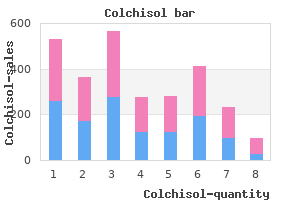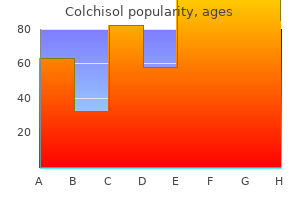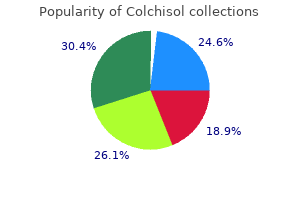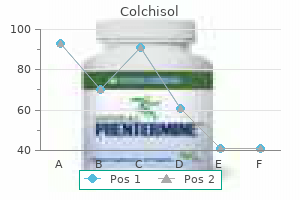

 5100 Springfield St. Suite 108, Dayton, Ohio 45431-1274
5100 Springfield St. Suite 108, Dayton, Ohio 45431-1274Colchisol
"Order colchisol 0.5 mg overnight delivery, infection 3 weeks after wisdom tooth extraction".
By: Z. Stan, M.B.A., M.D.
Medical Instructor, The Ohio State University College of Medicine
McLean first isolated heparin from ox liver and identified its anticoagulant properties best antibiotics for mild acne cheap colchisol online master card. Heparin structure consists of alternating residues of uronic acid and glucosamine that are variably sulfated infection 5 weeks after surgery buy colchisol 0.5 mg low price. Structure of the common active saccharide moieties found in commercial unfractionated heparin antibiotics effective against strep throat buy discount colchisol 0.5mg on line. From left to right, the saccharide structures are 2-deoxy-2-sulfamino-a-D-glucose-6-sulfate; a-L-iduronic acid-2-sulfate; 2-acetamido2-deoxy-a-D-glucose; b-D-glucuronic acid; and a-L-iduronic acid. Heparin is active when given parenterally, either intravenously or subcutaneously. Because of its highly charged nature and inability to cross biologic membranes alone, oral use of heparin has historically been viewed as impossible. Recently, delivery systems have been developed that make oral heparin a possibility and when sufficient amounts of heparin are administered orally, a prophylactic intensity of anticoagulation can be achieved. The clearance of heparin is also affected by the extent of thromboembolism, with extensive thrombosis decreasing heparin half-life. The anticoagulant effect of heparin is also altered by its nonspecific binding to plasma proteins and cells. When using intravenous heparin, the use of established nomogram-guided therapy is preferred. An additional challenge to the use of heparin to prevent and treat thrombosis is heparin resistance. Some have deemed a requirement of >35,000 U of heparin per 24-hour period, regardless of patient weight, to reflect this form of heparin resistance. The weight-based heparin dosing nomogram compared with a "standard care" nomogram. Significant experience exists with the administration of danaparoid by both intravenous and subcutaneous routes. The drug is approved for deep vein thromboprophylaxis after orthopedic surgery at a dose of 750 U anti-Xa twice daily by subcutaneous injection. A common dose for the treatment of active thrombosis in patients with normal renal function is 1,500 U as an intravenous bolus followed by 1,500 U subcutaneously twice daily. Pentasaccharides Because factor Xa is situated at the start of the common pathway of coagulation and upstream of thrombin in the cascade, it is an attractive target for new anticoagulants. By not directly inhibiting thrombin activity, factor Xa inhibitors might allow small amounts of thrombin to be generated, facilitating hemostasis and theoretically leading to a more favorable bleeding-risk profile. Elimination is also prolonged in patients >75 years of age and in those weighing <50 kg. A long-acting, hypermethylated pentasaccharide, idraparinux, and a similar compound with a biotin moiety at the reducing end unit allowing for neutralization with avidin, idrabiotaparinux, have a half-life of up to 130 hours, which may facilitate anticoagulation with once-weekly subcutaneous dosing. In these patients, elimination of all heparin exposure is the most essential element in the treatment. Two recombinant forms of hirudin, lepirudin, and desirudin, are available for clinical use. Allow at least 6 h between the first postoperative dose and the next postoperative dose. This paradoxic enhancement of the anticoagulant effect of lepirudin often warrants a significant reduction of infusion rate. When used for thromboprophylaxis, desirudin is given subcutaneously at a dose of 15 mg twice daily.

Just as in all other chronic hemolytic anemias infection jokes buy generic colchisol 0.5 mg on line, B19 parvovirus infection can temporarily shut down erythropoiesis antimicrobial socks order colchisol visa, rapidly worsening the anemia and resulting in an aplastic crisis infection 9gag cheap 0.5mg colchisol with visa. Anemia may also increase during infection and after treatment with oxidant drugs such as sulfonamides. The intensity of hemolysis is variable and is dependent on the mutation and fraction of abnormal hemoglobin present. The latter protects the b-globin heme group from oxidation and increased instability. They can include anisocytosis, basophilic stippling, Howell-Jolly bodies, nucleated red blood cells, and microspherocytes. Fragmented cells appear to have had a "bite" taken from them and are thought to result from the phagocytosis of Heinz bodies during passage of the cell through the spleen. The mean corpuscular hemoglobin concentration may be as low as 25 g/dl because of heme loss or Heinz body formation. Some reported values for reticulocytes may be factitiously high, as inclusion bodies are mistaken for reticulocytes. Heinz Body Preparation Heinz bodies in circulating red cells are usually seen only after splenectomy or during an acute hemolytic episode. Under such circumstances, >50% of the cells typically contain one or more large, spherical inclusions. Heinz body detection requires the incubation of erythrocytes with a supravital stain such as new methylene blue or crystal violet. The Heinz bodies appear as single or multiple inclusions of 2 mm in diameter or less and often appear attached to the membrane. Heinz bodies may be found in fresh blood, but usually, incubation for 24 hours without glucose is required for their formation. Hemoglobin Stability Tests the isopropanol test is a good screening test for unstable hemoglobins, but it can give false-positive results when the sample contains >5% HbF. Precipitates tend to be pale, and the pattern found during hemoglobin separation is characterized by lack of discrete peaks and multiple diffuse bands when electrophoresis is used, unless stabilized by the addition of hemin. Dipyrroluria is present, suggesting that free heme was converted to dipyrroles rather than bilirubin. About a quarter of unstable hemoglobins are not detectable by commonly used methods of hemoglobin separation. Pulmonary hypertension and priapism, common complications of hemolytic anemia, have been described in patients with unstable hemoglobins. The possibility of fever-associated hemolysis should be recognized, and avoidance of oxidant drugs, including acetaminophen and sulfonamides, are other management considerations. As in other chronic hemolytic anemias, the decision to perform a splenectomy must be balanced with the role of the spleen as a defense against pneumococcal infections early in life and the need for antipneumococcal vaccines and prophylactic penicillin in cases where splenectomy is performed in childhood. On balance, splenectomy might be beneficial for individuals with severe unstable hemoglobinopathies, and partial correction of the anemia is sometimes achieved. Hydroxyurea has been used to stimulate HbF production and help repair anemia in two cases of unstable hemoglobin disease.

Heterozygotes generally appear asymptomatic antimicrobial essential oil recipe purchase 0.5mg colchisol mastercard, as hemostasis can be maintained by factor X levels >10% of normal infection 8 weeks after birth generic colchisol 0.5 mg line. On the other hand antimicrobial jacket buy cheap colchisol line, compound heterozygotes and homozygotes with factor X levels <1% of normal suffer from severe bleeding. The disorder is associated with the absence of antigenically competent prekallikrein in most cases. The time required for release of vascular plasminogen activators in vivo after venous occlusion is prolonged. Detailed biochemical studies of five kindreds revealed considerable heterogeneity. Variable deficiency of prekallikrein also was present in the Williams, Fitzgerald, and Fujiwara kindreds; prekallikrein levels were normal in the Flaujeac kindred. Immunologic studies revealed the absence of kininogen antigen in the homozygotes and 50% of normal levels in the heterozygotes. Measurement of serum warfarin levels may be necessary to exclude surreptitious anticoagulant use. Other, more numerous abnormalities of the components of the antiprotease system and the fibrinolytic enzyme system that may be associated with thrombosis are discussed in Chapter 55. Fibrinogen degradation product levels and platelet counts were normal in most cases. Treatment of bleeding episodes with tranexamic acid and other antifibrinolytic agents may be helpful. ChaPtEr 53 Inherited Coagulation disorders Laboratory screening studies are typically normal, but the euglobulin clot lysis time is shortened. A second family was reported with the disorder; it is inherited in an autosomal dominant manner. Coagulation factor activity and clinical bleeding severity in rare bleeding disorders: results from the European Network of Rare Bleeding Disorders. This value was determined by purely empiric means-that is, by measurement of the blood levels of the deficient factor at which bleeding appeared to stop in patients with one of the inherited coagulation disorders during the course of replacement therapy. However, for patients with major trauma or those undergoing surgery, higher plasma levels of these coagulation proteins should be achieved. This latter method may be more precise in patients who do not have a normal plasma volume because of bleeding. Peak factor levels should be monitored to determine whether the expected response was achieved, and then further dosage adjustments can be calculated if necessary. Subsequent doses are scheduled according to the predicted half-life of the factor, with laboratory tests to verify actual levels when appropriate. Case reports and clinical experience detailing management of hemophilia A during surgery have been published. The adsorption of coagulation factors by platelets and various cell and vascular surfaces may also be involved. Typically, because the range of in vivo recovery in a population is so variable, clinicians will determine the in vivo recovery for each individual by laboratory testing of blood samples drawn 10 to 20 (peak level) minutes after the therapeutic infusion. Antifibrinolytic therapy should not be used with prothrombin complex concentrates. After in vivo mixing is complete, the activity of most coagulation factors in the plasma declines in a biphasic manner-that is, an initial rapid loss of activity is followed by a more gradual decline. In general, it is the rapidity of this first phase, together with the initial in vivo recovery of the particular factor, that determines the necessity for and the size of the preliminary or loading dose of therapeutic product.

Certain patterns of contusion can help identify the type of device causing the injury infection ear colchisol 0.5 mg. Skin bruises corresponding to the sites of seat belts are known as "seat belt mark" signs infection game app safe 0.5mg colchisol. It is important to recognize these antibiotic for sinus infection cefdinir purchase generic colchisol on-line, as the presence of this sign should alert physicians to the higher likelihood of internal injuries. Similarly, a bruise in the shape of a circle with central clearing may occur as a result of a blow from the circular edge of a pipe or spherical objects. The well-known Cullen sign refers to bluish discoloration around the umbilicus, and GreyTurner sign is flank ecchymosis. It is an autosomal dominant disorder characterized by multiple telangiectatic lesions involving the skin and mucous membranes associated with epistaxis and other bleeding complications. The mechanisms by which these genetic defects result in telangiectatic lesions have not been identified. The capillary segments eventually disappear, and direct arteriolar-venular communications are established. The bleeding manifestations are thought to occur because of mechanical fragility of these vessels. Common abnormalities in the hemostatic system do not seem to represent a major factor in the underlying bleeding tendency. Clinical Manifestations the cutaneous lesions usually appear in affected persons by 40 years of age, and they increase in number with age. The lesions measure 1 to 3 mm in diameter and are sharply demarcated in appearance. They blanch with pressure, but the blanching may be incomplete as a result of "strangulation" of coiled loops of vessels. Bleeding from these cutaneous telangiectasias is uncommon and rarely of clinical importance. One report suggests that capillaroscopy of the dorsal hands can detect morphologic changes in the skin microcirculation, including microscopic telangiectatic lesions, but the clinical utility of this is undefined. Paradoxic emboli can occur and result in brain abscesses, transient ischemic attacks, and strokes. Gravitational shifts in blood flow to the lung bases result in increased right-to-left shunting in the sitting or standing position. Hepatic involvement occurs in 70% of patients, but symptoms and complications are rare. These shunts can lead to clinical complications of high-output heart failure, portal hypertension, encephalopathy, biliary ischemia, and nodular regenerative hyperplasia. Additionally, if patients with known focal nodular hyperplasia are being treated with estrogen or progesterone therapy, close monitoring is indicated with discontinuation of hormones in the case of symptomatic tumor enlargement. In a fully developed cutaneous telangiectasia, the venule (V) and its branches have become dilated and convoluted throughout the dermis. The connecting arterioles (A) have also become dilated and communicate directly with the venules without intervening capillaries. This symptom results from bleeding telangiectatic lesions over the inferior turbinates and nasal septum. Approximately one-third of patients have mild symptoms requiring no treatment, and another third have moderate symptoms requiring only outpatient treatment. The remaining third have severe symptoms often requiring inpatient treatment, transfusions or chronic iron replacement therapy, and surgery.

This suggests that dose alteration will be needed for renal insufficiency infection quarantine order 0.5 mg colchisol otc, but studies in patients with renal failure have not been completed infection near eye cheap colchisol online visa. Mild bacteria reproduce using order colchisol 0.5mg, reversible neurotoxicity has been seen at lower doses, with increased frequency and severity in older patients. Fludarabine is immunosuppressive and is associated with an increased risk of opportunistic infections. Cladribine (Leustatin or 2-chlordeoxyadenosine, 2CdA), an adenosine analog found to be more cytotoxic to lymphocytes than fludarabine, is used to treat hairy cell leukemia. As with cladribine and fludarabine, clofarabine is phosphorylated intracellularly to the active triphosphate form. The primary toxicity of clofarabine is myelosuppression leading to an increased risk of infection. Severe reversible hepatic toxicity is noted in 15% to 40% of patients receiving clofarabine. Clinical studies have demonstrated hyperacetylation in tumor cells following vorinostat administration. However, no correlation between tumor acetylation status and response has been seen, suggesting that other mechanisms of action may impact on antineoplastic activity. The silenced genes may play an important role in terminal differentiation, apoptosis, or senescence of leukemic cells. It is active in the treatment of chronic lymphoid malignancies, particularly hairy cell leukemia. Dosage reduction should be considered for patients with impairment in renal function. Clinical pharmacology At doses used in hairy cell leukemia (4 mg/m2 biweekly), therapy is usually well tolerated. Amino acid residues on the histone tail can be modified by acetylation and by methylation. Both vorinostat and romidepsin are primarily inactivated by metabolism (glucuronidation and hydrolysis) with metabolites excreted in the urine. Vorinostat has a short half-life (2 hours); despite the short plasma half-life, accumulation of acetylated histones continues for over 10 hours after administration. However, since drug clearance is primarily via metabolism, dose adjustment for renal insufficiency is not thought to be needed. The half-lives of 5-azacytidine and decitabine are 4 hours and 30 minutes, respectively. The drugs do not have oral bioavailability because of rapid decomposition in acidic solutions. Gastrointestinal toxicities, including nausea, vomiting, and constipation, are seen, usually transient in nature (1 to 4 days), and improve over time. Of the several types of hormonal agents used in cancer therapy, corticosteroids are the class of drugs used to treat hematologic malignancies. Corticosteroids are also useful in managing complications of cancer, including chemotherapy-induced emesis, hypercalcemia, and increased ChaPtEr 68 Principles and Pharmacology of Chemotherapy intracranial pressure. Prednisone and dexamethasone are synthetic glucocorticoids most commonly used in oncology. They are respectively 4- and 30-fold more potent than the naturally occurring glucocorticoid, cortisol. Prednisone and cortisol have roughly equivalent mineralocorticoid effects while dexamethasone lacks significant mineralocorticoid activity. Mechanism of Action Several cancers depend on specific hormones for growth and cellular integrity.
Buy cheapest colchisol. How to help keep antibiotics working.